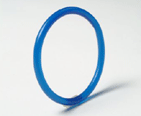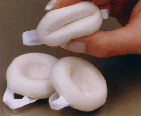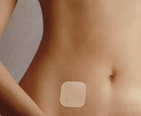 There are a lot of benefits of vaginal contraceptive ring. One of the most important is that a woman has to care about birth control only once a month and does not have to worry about forgetting to take a birth control pill. Sexual intercourse might get more spontaneous since a woman does not have to stop lovemaking in order to take a contraceptive or spermicide. The effectiveness of a vaginal contraceptive ring is 98-99%. However, it may decrease if the ring is used improperly or for less or more than three weeks. The risk for pregnancy also increases if a woman is taking specific medicines, such as antibiotics, tuberculosis, anti-seizure and migraine medications.Women using the ring have lighter and regular periods; they also do not experience the PMS syndrome and have a decreased risk for endometrial and ovarian cancers. Some scientific data show that a vaginal contraceptive ring decreases the risk for inflammatory pelvic disease and ectopic pregnancy.
There are a lot of benefits of vaginal contraceptive ring. One of the most important is that a woman has to care about birth control only once a month and does not have to worry about forgetting to take a birth control pill. Sexual intercourse might get more spontaneous since a woman does not have to stop lovemaking in order to take a contraceptive or spermicide. The effectiveness of a vaginal contraceptive ring is 98-99%. However, it may decrease if the ring is used improperly or for less or more than three weeks. The risk for pregnancy also increases if a woman is taking specific medicines, such as antibiotics, tuberculosis, anti-seizure and migraine medications.Women using the ring have lighter and regular periods; they also do not experience the PMS syndrome and have a decreased risk for endometrial and ovarian cancers. Some scientific data show that a vaginal contraceptive ring decreases the risk for inflammatory pelvic disease and ectopic pregnancy.
Disadvantages of vaginal contraceptive pills
Although there are many advantages of a vaginal contraceptive ring , as with all hormonal birth control methods, there are some risks, complications and disadvantages. One of the most frequent disadvantages is an accidental slip out of a vaginal contraceptive ring from the vagina. This could be protected with a proper use of the ring. Some women and their partners may feel the ring in the vagina during sexual intercourse. However, most of the women do not feel the ring in their vagina at all and those who do do not describe the sensation as strong or painful and uncomfortable.
Side effects of vaginal contraceptive pills
More serious side effects of a vaginal contraceptive ring are yeast infection and an increased vaginal discharge and irritation. Some women might get respiratory infection or sinus infection. Women who use the ring complain with nausea, headache, weight gain, breast swelling and tenderness, spotting and breakthrough bleeding or even depression. There are also certain increased risks for serious complications, such as formation of blood clots in the legs, heart and brain. While using a vaginal contraceptive ring there is an increased risk for stroke, hart attack and gall bladder disease. The use of hormonal birth control, as well as the ring, may increase the risk for breast and cervical cancer.
Although most women, after consulting with their doctor, may use a vaginal contraceptive ring, there is a group of women who should consider it very carefully before starting to use this particular mean of birth control. These conditions include high blood pressure and high cholesterol, diabetes, since such women has already got an increased risk for stroke and heart attack. Women, who have the history of breast cancer or breast cancer was in their family should choose another method of contraception . Other conditions, when another method of birth control should be used include gall bladder and kidney disease, epilepsy, depression, sensitive vagina, dropped uterus or bladder, rectal prolepses and others. Women should use another method of birth control while they are breast feeding their babies.
This vaginal contraception method is a safe, effective and comfortable way to protect against unexpected pregnancy. As with all hormonal birth control methods, there are certain advantages and disadvantages of the method. Before deciding whether to use the ring or not, you should evaluate all the pros and cons of this particular mean of birth control. And if you still have further questions, do not hesitate to consult your doctor and discuss all the possible benefits and risks and possible complications of a vaginal contraceptive ring.
 You are probably now wondering how the ring works in birth control. Its action is due to female hormones – estrogen and progesterone — that are absorbed into a female bloodstream through vaginal walls. These two hormones suppress ovulation, meaning that no egg is produced in the ovary. They also thicken the mucus on the cervix, so that it is complicated for the sperm to enter the uterus. The last action of the combination of estrogen and progesterone is the change of uterine lining in such a way that it is almost impossible for a fertilized egg to implant. Bear in mind that although a vaginal contraceptive ring is efficient in birth control, it does not protect against any of sexually transmitted diseases. Therefore a
You are probably now wondering how the ring works in birth control. Its action is due to female hormones – estrogen and progesterone — that are absorbed into a female bloodstream through vaginal walls. These two hormones suppress ovulation, meaning that no egg is produced in the ovary. They also thicken the mucus on the cervix, so that it is complicated for the sperm to enter the uterus. The last action of the combination of estrogen and progesterone is the change of uterine lining in such a way that it is almost impossible for a fertilized egg to implant. Bear in mind that although a vaginal contraceptive ring is efficient in birth control, it does not protect against any of sexually transmitted diseases. Therefore a  Injectable contraceptives are a rather safe type of birth control they, however, may cause several side-effects which tend to be more obvious than those caused by the use of a
Injectable contraceptives are a rather safe type of birth control they, however, may cause several side-effects which tend to be more obvious than those caused by the use of a  The contraceptive sponge is a soft sponge that contains
The contraceptive sponge is a soft sponge that contains  Taking care of your health is very important. Regular visits to your general practitioner as well as to a gynecologist are must if you care about your body and want to stay healthy. Specialists say that women need to see their gynecologist at least once a year since the beginning of their sexual life. Others say that it is important to have a
Taking care of your health is very important. Regular visits to your general practitioner as well as to a gynecologist are must if you care about your body and want to stay healthy. Specialists say that women need to see their gynecologist at least once a year since the beginning of their sexual life. Others say that it is important to have a  Although a contraceptive patch was found to be highly effective in birth control, there are certain factors that may affect its efficiency. Effectiveness of the patch may decrease with the improper use. In addition, women who weigh more than 198 pounds should choose other
Although a contraceptive patch was found to be highly effective in birth control, there are certain factors that may affect its efficiency. Effectiveness of the patch may decrease with the improper use. In addition, women who weigh more than 198 pounds should choose other